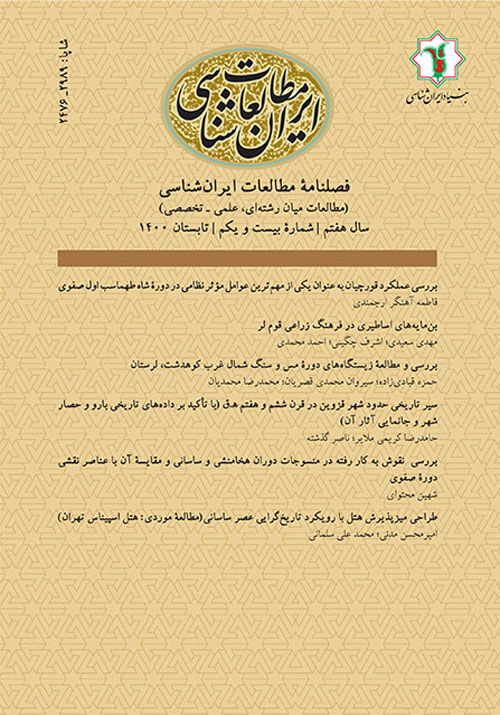Representation of Womanhood on the Cylinder Seals of Proto-Historic Iran and Construction of Social Reality: A Case Study of Ancient Susiana (3500-1000 BC)
Author(s):
Article Type:
Case Study (بدون رتبه معتبر)
Abstract:
Institutionalized or social reality is one of the concepts in contemporary philosophy which discusses the different ways of the formation of realities that only exist when a group of people believe in them and pay attention to them. However, such realities are rooted in non-institutionalized realities which are still real in the absenceof any human representation; nevertheless, they are different in that the former is only meaningful within human representational systems. One of the features of institutionalized realities is that they are based on a conceptual triangle the three sides of which are comprised of human, act/event, and the created or matter. Therefore, artifacts play a natural and constructive role in the realization of an institutionalized reality. Such realities are always created in contexts which are not representational themselves. In this paper, the writers demonstrate that cylinder seals, as one of the most important commercial tools of the Bronze Age in West Asia and ancient Iran, were one of the most significant products of institutionalized realities which depended on commerce and could not be realized without the establishment of commercial-economic structures of early urbanism. Rather, after becoming actualized, they turned into a material device used for expanding the regional and trans-regional economic system.
The images on cylinder seals, on the other hand, hold a noteworthy place in creating and delivering certain types of institutionalized or representational realities. They can create, transfer, and reproduce some beliefs among the members of their society which are deemed necessary in the formation of its structure. This paper discusses the images and representations of women’s bodies on cylinder seals and their rolein the creation of the institutionalized realities which pertain to women and womenhood. The main elements in relation to womenhood which have been identified in this study include women’s A forms, crafted forms, collective and dramatic-ritualized forms, and women’s B forms with an emphasis on gendered body. The findings also demonstrate that such images were presented and transformed in conformity with various social contexts and backgroundsin three cultural-social periods or trends in ancient Susiana (3500-1000 BC) in the southwest of Iran.
The images on cylinder seals, on the other hand, hold a noteworthy place in creating and delivering certain types of institutionalized or representational realities. They can create, transfer, and reproduce some beliefs among the members of their society which are deemed necessary in the formation of its structure. This paper discusses the images and representations of women’s bodies on cylinder seals and their rolein the creation of the institutionalized realities which pertain to women and womenhood. The main elements in relation to womenhood which have been identified in this study include women’s A forms, crafted forms, collective and dramatic-ritualized forms, and women’s B forms with an emphasis on gendered body. The findings also demonstrate that such images were presented and transformed in conformity with various social contexts and backgroundsin three cultural-social periods or trends in ancient Susiana (3500-1000 BC) in the southwest of Iran.
Keywords:
Language:
Persian
Published:
نشریه مطالعات ایرانشناسی, Volume:3 Issue: 5, 2017
Pages:
8 to 26
magiran.com/p1992018
دانلود و مطالعه متن این مقاله با یکی از روشهای زیر امکان پذیر است:
اشتراک شخصی
با عضویت و پرداخت آنلاین حق اشتراک یکساله به مبلغ 1,390,000ريال میتوانید 70 عنوان مطلب دانلود کنید!
اشتراک سازمانی
به کتابخانه دانشگاه یا محل کار خود پیشنهاد کنید تا اشتراک سازمانی این پایگاه را برای دسترسی نامحدود همه کاربران به متن مطالب تهیه نمایند!
توجه!
- حق عضویت دریافتی صرف حمایت از نشریات عضو و نگهداری، تکمیل و توسعه مگیران میشود.
- پرداخت حق اشتراک و دانلود مقالات اجازه بازنشر آن در سایر رسانههای چاپی و دیجیتال را به کاربر نمیدهد.
In order to view content subscription is required
Personal subscription
Subscribe magiran.com for 70 € euros via PayPal and download 70 articles during a year.
Organization subscription
Please contact us to subscribe your university or library for unlimited access!



